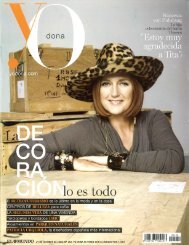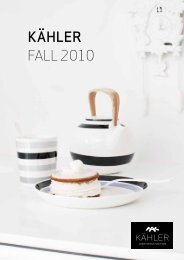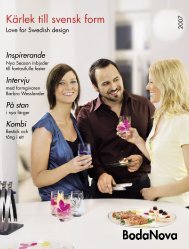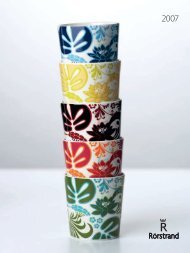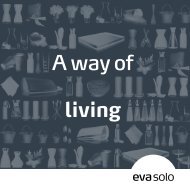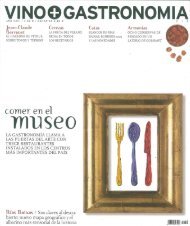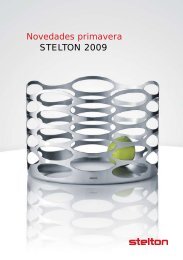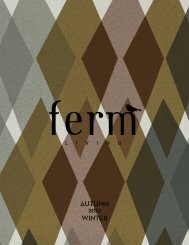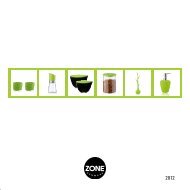ENGLISH - Caprichos Daneses
ENGLISH - Caprichos Daneses
ENGLISH - Caprichos Daneses
Create successful ePaper yourself
Turn your PDF publications into a flip-book with our unique Google optimized e-Paper software.
<strong>ENGLISH</strong>
In 1990, Piet Hein established the company Piet Hein A/S, which<br />
owns and manages all of Piet Hein’s inventions, texts and designs.<br />
The company has two main tasks:<br />
• To collect, sort and register information about Piet Hein, from<br />
either anecdotes or physical effects.<br />
• To ensure the activation of Piet Hein high-quality products.<br />
In the years to come, ‘new’ Piet Hein products will see the light of<br />
day, based on his original drawings and models.
BORN 16-12-1905 – DIED 17-04-1996<br />
Piet Hein was born on 16.12.1905 in Copenhagen, the only<br />
child of graduate engineer Hjalmar Hein and eye specialist<br />
Estrid Hein. Along with another engineer, his father owned<br />
the development firm Hein & Møller-Holst, where he made<br />
use of his talents as an inventor (HeinHolst lifts). His mother<br />
was one of the first female doctors in Scandinavia; she was<br />
politically active and was chairwoman of a number of social<br />
commission in the League of Nations. The family lived in the<br />
house at Gammel Torv 10-12, Copenhagen, which the firm<br />
had built.<br />
There are indications that Piet Hein had quite an unusual<br />
childhood. He relates, for example, that at the age of 5-7<br />
he assisted his mother at an eye operation on his nurse. The<br />
girl had had her blind eye removed in an operation a couple<br />
of weeks previously, and now little Piet stood on a chair<br />
holding the empty eye cavity of his nurse open while his<br />
mother removed the stitches from the rear wall of the eye.<br />
3
Piet Hein began to draw at an early age. The first drawings,<br />
hidden away to this very day, are from the age of five. He<br />
completed his upper secondary education at Metropolitanskolen<br />
in 1924 and began the compulsory preliminary philosophy<br />
studies at the university. At the same time, he had<br />
private drawing lessons to help him get in at the Academy<br />
of Fine Arts in Copenhagen (he draw, among other things,<br />
sculptures at the Glyptotheque) – but to no avail. This did<br />
not disconcert him, however. He continued to Stockholm,<br />
where he was accepted at Kungliga Svenska Konsthögskolan,<br />
with Albert Engström as teacher. He lived with his aunt and<br />
uncle – Emma and Erik Scavenius – in Stockholm while attending<br />
the college.<br />
After his stay in Sweden, it was his talent for the exact<br />
sciences that was to be put to the text. He began to study<br />
physics and epistemology at the University of Copenhagen<br />
and studied and worked at the Niels Bohr Institute. Subsequently,<br />
it was the practical use of technology that appealed<br />
to him. He made various discoveries, for which he sought<br />
patents, worked in a professional capacity in connection<br />
with various companies – and began to write more. He himself<br />
says that from that time on, he spent 50% of his time<br />
writing and 50% on the technical side of things.<br />
Throughout his life, Piet Hein was actively interested in the<br />
cause of minorities and in peace between the great nations<br />
– an attitude he demonstrated with his famous Grook<br />
Co-existence or no existence. For twenty years, he was a<br />
member of the executive committee of The Open Door, was<br />
co-founder of the League for Tolerance and chairman of the<br />
Danish branch of the World Movement for World Federation.<br />
4
In the years leading up to the Second World War, Piet Hein<br />
was a member of the anti-nazi association Liberal Cultural<br />
Struggle, which worked for democracy and against dictatorship.<br />
A few days before the German occupation of Denmark,<br />
he accepted the post of chairman in the association, and<br />
a few days later – on 14 April 1940 – as his first teasing<br />
comment on the occupying power he came up with a double<br />
entendre (the Danish word ‘længes’ means both ‘to long’ and<br />
‘to grow long’) poem – Piet Hein’s first Grook:<br />
SPRING SADNESS<br />
The days<br />
are longing,<br />
longing, longing.<br />
What are they<br />
longing for<br />
The days<br />
are longing<br />
l o n g i n g<br />
longing<br />
for midsummer.<br />
This marked the beginning of the world-famous Grooks,<br />
which have since appeared in every conceivable language.<br />
There are over 8000 of them.<br />
During the war, Piet Hein had a Jewish wife. And in 1943,<br />
he left Denmark with his family for Buenos Aires in Argentina,<br />
where they lived for a couple of years. There Piet Hein<br />
continued his own personal struggle against the Nazis,<br />
producing a long series of satirical drawings for the Buenos<br />
Aires Herald that featured Hitler, Goebbels and Mussolini as<br />
main characters.<br />
7
In Argentina, Piet Hein missed his native clime so much<br />
that he made a Great Bear candlestick out of steel wire that<br />
could be lit and remind him of the night sky in Denmark.<br />
The Great Bear can also be seen sketched in many Grook<br />
vignettes and in this Grook:<br />
TO THE GREAT BEAR<br />
May childhood’s old acquaintance<br />
from heaven’s farthest shore<br />
that overcomes time’s breakers<br />
and lasts for evermore<br />
stand lit like candles seven<br />
in winter’s darkest heaven<br />
and shine your peace so pure<br />
The drawing of the little man Kumbel Kumbell with a lyre in<br />
his hand first appears in 1940 as a vignette drawing for the<br />
Grooks. Originally, Piet Hein did not intend to have drawings<br />
with his Grooks – but he did not feel the texts should only<br />
be decorated with roses and other garden treasures as other<br />
illustrators did. So quite soon there was a drawing along<br />
with each Grook he wrote – and this proved to be a popular<br />
combination.<br />
8
In the early 1950s, Piet Hein was quite often in USA. Among<br />
other things, he did humorous drawings for The New Yorker.<br />
He also worked freelance for Politiken in the same period,<br />
sending popular scientific articles home about such things<br />
as the World’s greatest magnetic field, the Radio Hat and<br />
Einstein.<br />
10
Piet Hein together with Charlie Chaplin in Irland.<br />
Piet Hein had many talents, and he tried all of them out in<br />
the course of his life. He was in personal contact with such<br />
scientific ‘heavyweights’ of his time as Albert Einstein and<br />
Niels Bohr, as well as Chaplin and Norbert Weiner, of whom<br />
he was a close friend.<br />
11
He was an honorary doctor of a number of universities.<br />
Many of his inventions were put into production. He<br />
became world-famous with his superellipse, originally<br />
designed for Sergels Torg in Stockholm and later used for<br />
many things, including Mexico Stadium, the table, architecture,<br />
the swimming pool of the DGI village, table-toppings,<br />
handles, etc.<br />
Sergels Plaza in Stockholm<br />
Mexico Stadium<br />
12
www.piethein.com<br />
PRODUCTS
2<br />
The great bear
CANDLEHOLDER<br />
THE GREAT BEAR<br />
In Argentina, Piet Hein missed his native clime so much that he made<br />
a Great Bear candlestick out of steel wire that could be lit and remind<br />
him of the night sky in Denmark. The Great Bear can also be seen<br />
sketched in many Grook vignettes.<br />
NORMAL [95.80.10]<br />
MAXI [50.050]<br />
3
Saturn, Jupiter, Venus<br />
and Mars maxicandle holders.<br />
MULTICANDLEHOLDER<br />
The beautiful shape of the superellipse®<br />
is turned in to an elegant holder which<br />
can hold a tealightcandle or a normal<br />
candle – just by turning it.<br />
4<br />
[95.80.22]
CANDLEHOLDERS<br />
Mars 14 cm [95.80.11]<br />
Venus 21 cm [95.80.12]<br />
Jupiter 29 cm [95.80.13]<br />
Saturn 36 cm [95.80.14]<br />
MAXI<br />
Mars 32,0 cm [95.80.44]<br />
Venus 47,5 cm [95.80.43]<br />
Jupiter 65,0 cm [95.80.42]<br />
Saturn 80,5 cm [95.80.41]<br />
CANDLEHOLDER 24x19 CM<br />
Superelliptic glas.<br />
[95.80.27]<br />
GREASE GUARD<br />
Available for ordinary<br />
and MAXI-holders.<br />
Ø20 MM [95.80.16]<br />
Ø50 MM [95.80.18]<br />
5
SUPER-EGG AS »ANTI-STRESS-EGG«<br />
[22.14.55]<br />
The superegg is a sculpture, a game and an amulet. It<br />
is a spacious elaboration of the SUPERELLIPSE®. It is<br />
able to stand upright on both ends – without cheating.<br />
6
drinkcooler<br />
DRINKCOOLER<br />
[22.73.40]<br />
THE SUPEREGG<br />
7
SUPERELLIPTICAL SERVING TRAY 16,5X12 CM<br />
Stainless Steel<br />
[95.80.26]<br />
UPERELLIPTICAL SERVING TRAY 41X31 CM<br />
Stainless Steel<br />
8<br />
[14.80.28]
TRAYS<br />
In addition, two trays medium-sized,<br />
can be supplied from 2005-09-01<br />
17x24 CM [100.32]<br />
24x32 CM [100.33]<br />
9
BOWL Ø 8 CM.<br />
[95.80.60]<br />
The bowls were originally made of silver<br />
for a competition at Georg Jensen in<br />
1967. The bowls now manufactured are<br />
of stainless steel.<br />
BOWL Ø 13 CM<br />
[95.80.61]<br />
10
owls<br />
STAINLESS STEEL<br />
BOWL Ø 10.5 CM.<br />
[95.80.61]<br />
In addition, two bowls can be supplied from 2005-09-01<br />
Ø 15,5 CM [10044]<br />
Ø 18,0 CM [10045]<br />
11
PEBBER MILL<br />
[95.80.24]<br />
SALT MILL<br />
[95.80.25]<br />
PEPPER SPRINKLER<br />
[10.027]<br />
SALT SPRINKLER<br />
[10.026]<br />
pepper<br />
12
STAINLESS STEEL<br />
salt<br />
13
DISH 19X25 CM<br />
The smallest dish is perfect for making sautéed dishes and<br />
can be brought to the table directly from the oven.<br />
[86.50.12]<br />
DISH 23X30 CM<br />
The shape of Superellipse® offers the greatest possible<br />
volume as you will experience while using it.<br />
[86.50.14]<br />
DISH 27X35 CM<br />
The dishes are very easy to clean due to the simple design.<br />
[86.50.16]<br />
14<br />
DISH 26X26 CM<br />
One can be nothing but inspired by this supercircular dish.<br />
An exciting shape for exciting dishes.<br />
[86.50.18]
The collection of the heat resistant<br />
dishes is made of porcelain.<br />
They are safe to use in the oven,<br />
Micro-wave, freezer and dish washer.<br />
PORCELAIN<br />
15
The collection of the<br />
heat resistant bowls is<br />
made of porcelain.<br />
BOWL Ø 10 CM<br />
[86.50.01]<br />
BOWL Ø 14 CM<br />
16<br />
[86.50.03]
owls<br />
BOWL Ø 18 CM<br />
The superellipse® is the<br />
most spacious shape and as<br />
such very useful for serving.<br />
PORCELAIN<br />
[86.50.06]<br />
BOWL Ø 21 CM<br />
The bowl is suitable for<br />
serving potatoes and<br />
vegetables but only the<br />
imagination sets the limit.<br />
[86.50.08]<br />
BOWL Ø 26 CM<br />
With the simple design, the<br />
largest bowl in the series<br />
seems elegant on the table.<br />
Especially suitable for large<br />
salad portions.<br />
[86.50.10]<br />
17
Can be used as<br />
serving boards for the<br />
porcelain dishes<br />
CARVING BOARD 28X35 CM<br />
The smallest carving board is perfect for bread<br />
and other small things. Fits the porcelain dish<br />
23x30 cm as a serving board.<br />
[24.65.10]<br />
18
CARVING BOARDS<br />
CARVING BLOCK<br />
One can be nothing but inspired by this<br />
super circular carving block.<br />
fits the super circular porcelain dish<br />
26x26 cm as an exciting serving board.<br />
[24.65.20]<br />
CARVING BOARD 36X45 CM<br />
The shape of SUPERELLIPSE® makes up<br />
the basic for this size. Perfect for slicing<br />
the well prepared roast. Fits the porcelain<br />
dish 27x35 cm as a serving board.<br />
[24.65.15]<br />
19
OPENER<br />
Stainless steel<br />
[10.025]<br />
The bottle opener DeCap<br />
can open both traditional<br />
caps and, furthermore,<br />
the sometimes stubborn<br />
screw-caps.<br />
DeCap<br />
20
21<br />
OPENER
The game of CON-TAC-TIX® occurred to Piet Hein while<br />
he was contemplating the famous four-colour theorem<br />
of topology. The theorem, as yet unproved, is that four<br />
colours are sufficient to make any map so that no two<br />
countries of the same colour have a common boundary .<br />
Piet Hein introduced the game in 1942 at the Niels Bohr<br />
22
GAMES<br />
CON-TAC-TIX<br />
Institute. The same year a leading Danish news paper<br />
published an account of the game; it soon became<br />
enormously popular in Denmark (under the name of<br />
Polygon). Albert Einstein who was passionately inter ested<br />
in games had since 1948 Piet Hein’s CON-TAC-TIX® on<br />
a shelf in his study.<br />
[30.140]<br />
23
COLLECTED GROOKS I<br />
185 grooks<br />
[40.001]<br />
COLLECTED GROOKS I<br />
185 grooks<br />
[40.002]<br />
24
Many people have reviewed Piet Hein’s<br />
ingenious verses over the years and sought<br />
for a deeper meaning hidden in their overall<br />
name »Grook«. Could »Gruk« (the Danish<br />
name) be a contraction of GRin (laugh) and<br />
sUK (sigh) Or was the name simply taken<br />
out of thin air – as Piet Hein himself often<br />
said. One thing is certain – Grook was a<br />
completely new and brilliantly apt title for<br />
the ingenious verses paid for by the line and<br />
written for the »Politiken« column ATS from<br />
1940 until 1961.<br />
GROOKS<br />
25
26Astro calendar
CALENDAR<br />
Piet Hein made this Astro Calendar in 1968, which<br />
covers a period of 300 years. It is possible to work out<br />
which day of the week a particular event has taken place<br />
- or will take place.<br />
[40.200]<br />
27
THE RA LAMP<br />
The Ra lamp, which is listed among Piet Hein’s first<br />
inventions, was designed already in 1931 and will now<br />
be produced.<br />
It is based on a previously unnoticed phenomenon of<br />
spatial geometry and inspired by an old sun sign: the<br />
circular disc with a mark in the centre.<br />
The anti-dazzle lamp is a fine example of Piet Hein’s<br />
at once academic and poetic approach to design.<br />
BAR STOOL<br />
Designed in 1968.<br />
78 CM - [50.560]<br />
62 CM - [50.561]<br />
28
MISCELLANEOUS<br />
FLAGPOLE 50 CM<br />
Tri-superelliptic base<br />
and superegg top.<br />
All national flags can be supplied.<br />
[95.80.28]<br />
29
Helix Helios<br />
SUNDIAL<br />
The sundial is now available<br />
in heights of 2, 4 and<br />
11 meters.<br />
2 METER [50.601]<br />
30<br />
Every sundial is uniquely numbered
31<br />
SUNDIAL


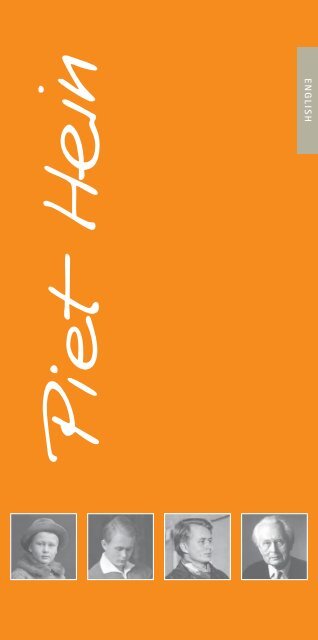
![Page 1 Germs que n@ Ape'mwsejä si « 1\/Hn]b0f;21df \ de placer ...](https://img.yumpu.com/50048094/1/182x260/page-1-germs-que-n-apemwseja-si-a-1-hnb0f21df-de-placer-.jpg?quality=85)

